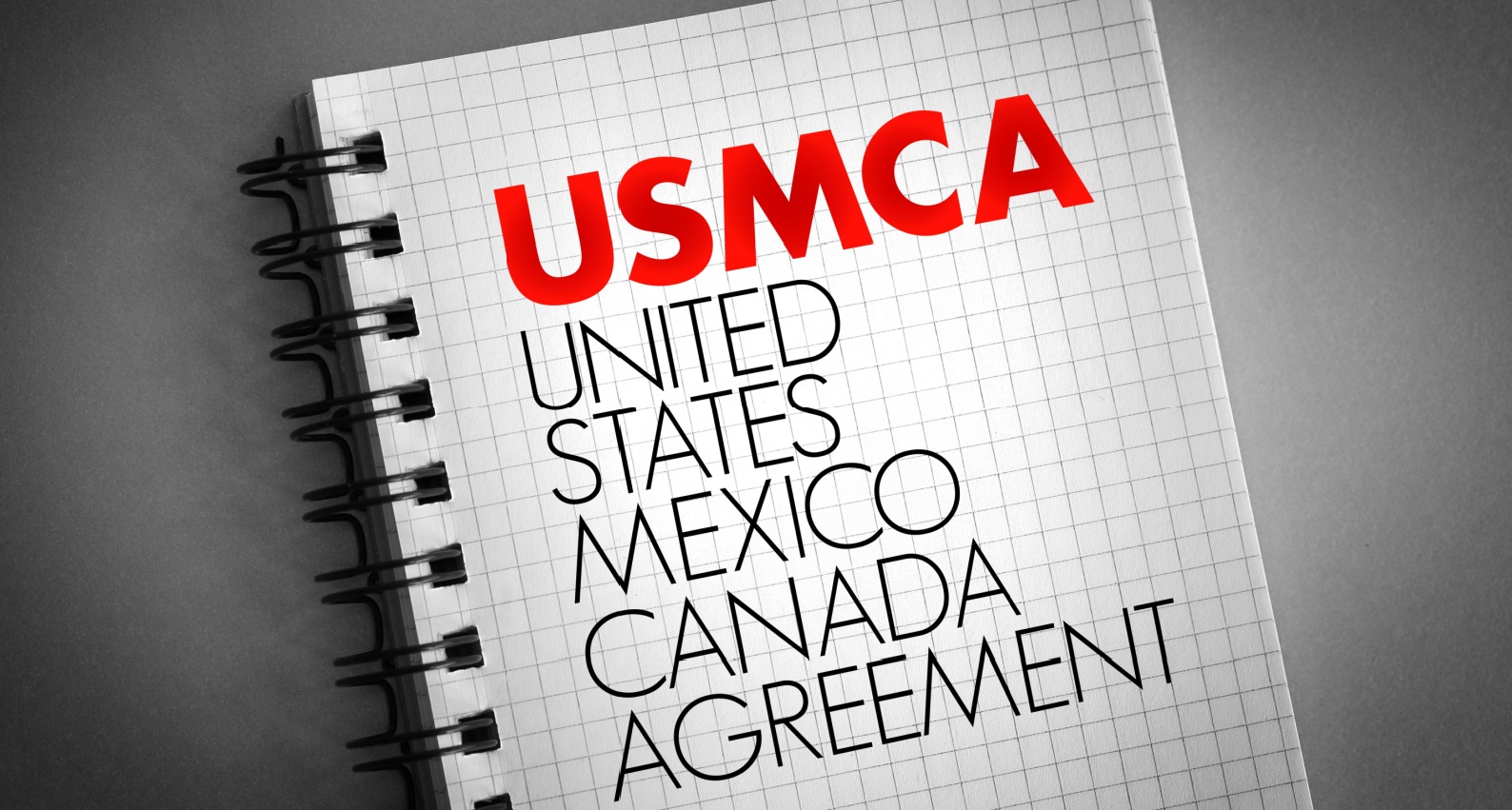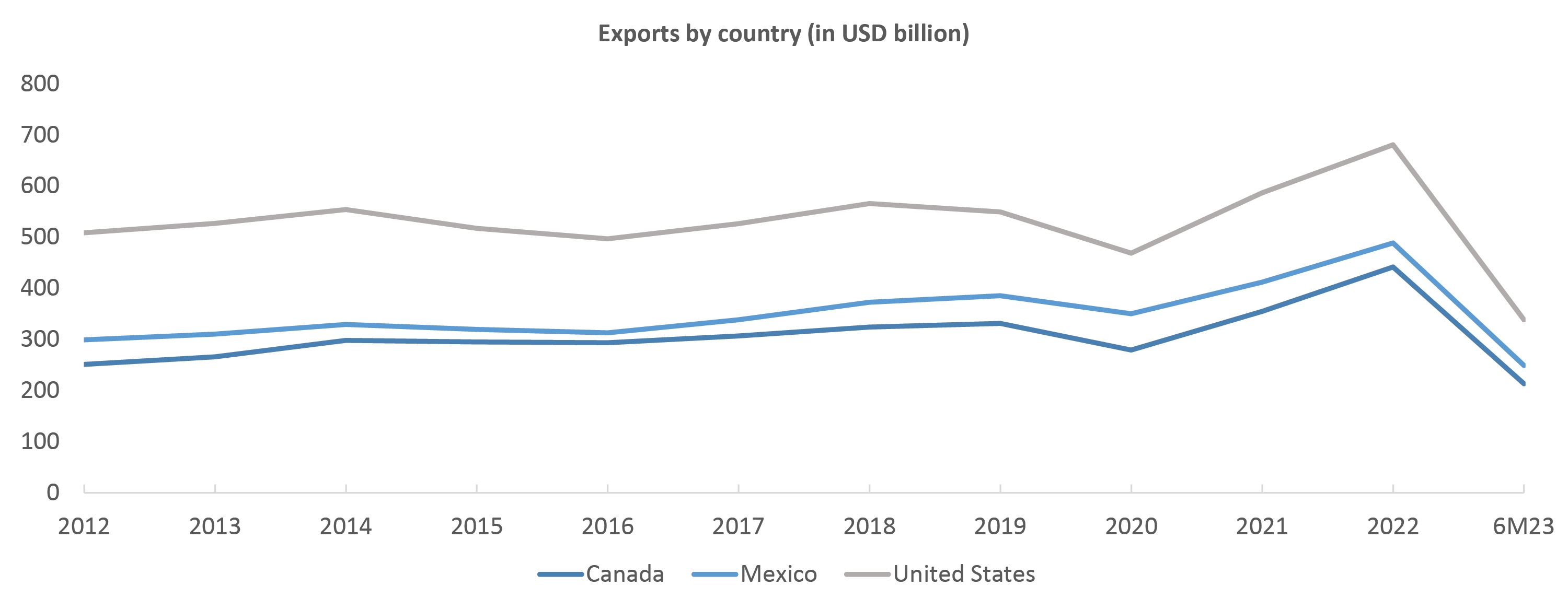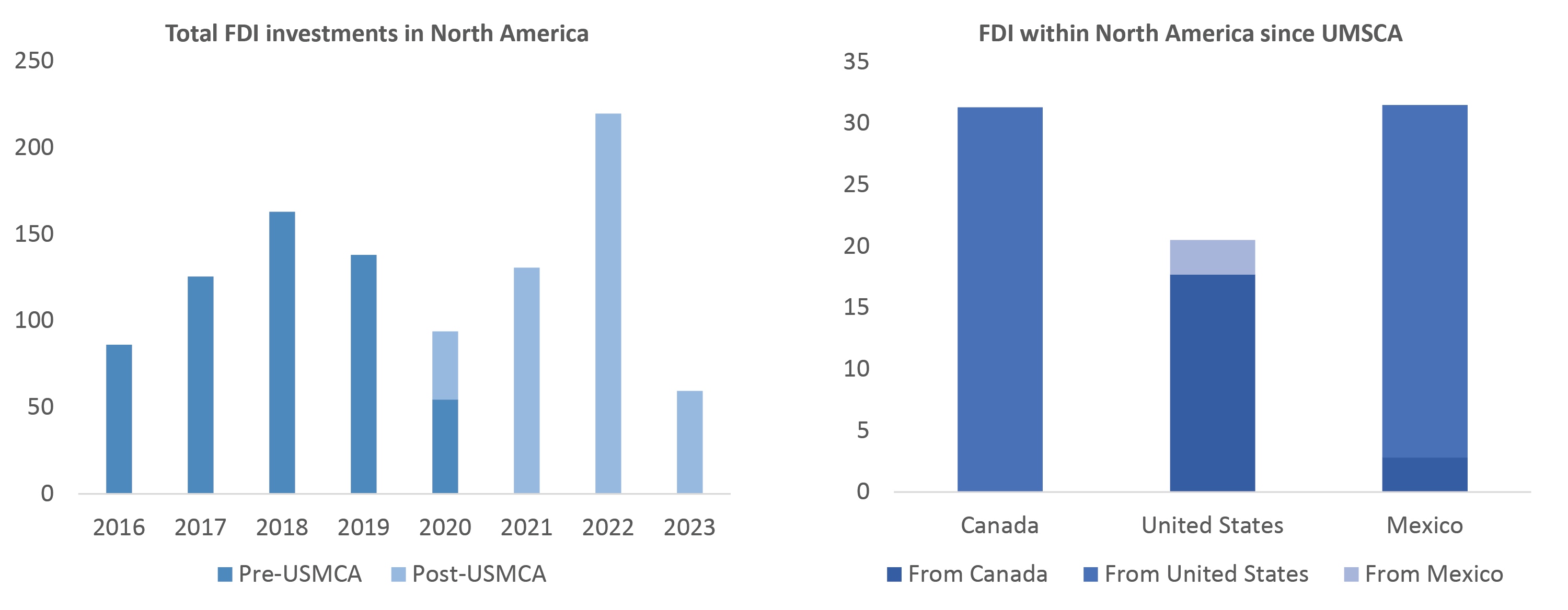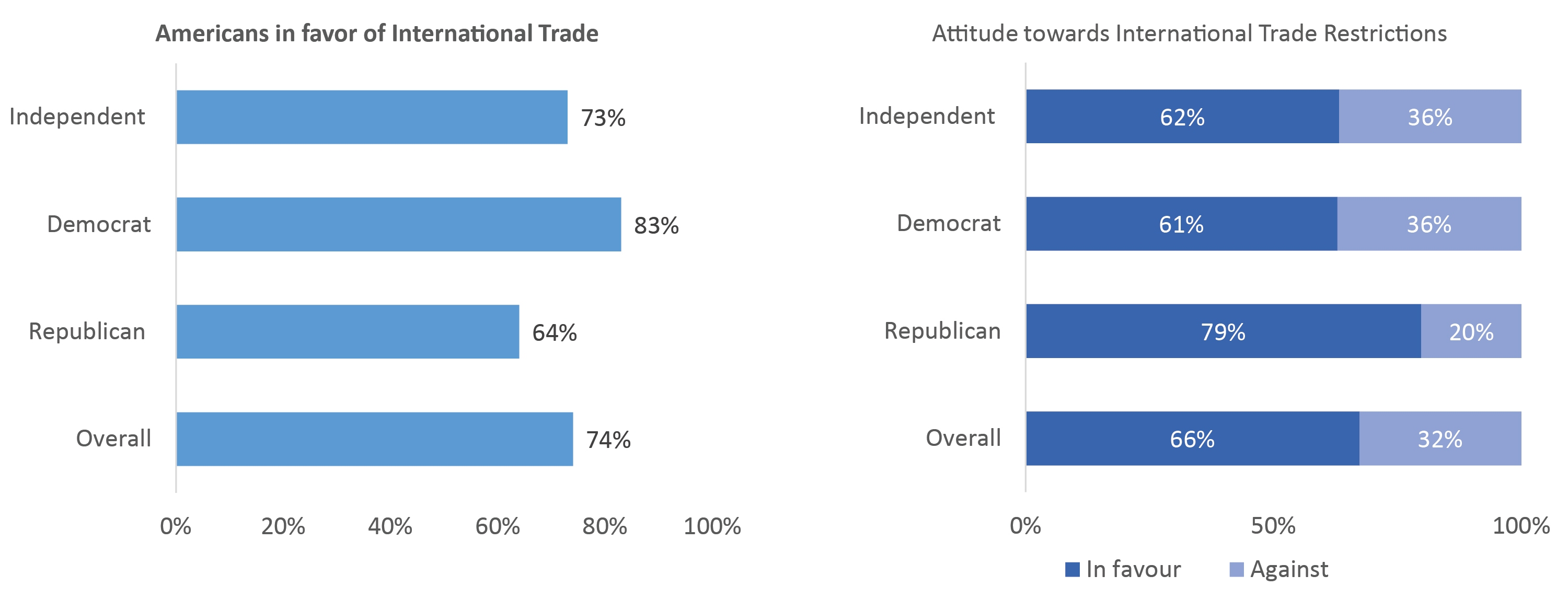USMCA - A Three-Year Retrospective and its impact
Published on 22 Nov, 2023

The US–Mexico–Canada Agreement (USMCA), implemented in 2020, replaced North American Free Trade Agreement (NAFTA) and has significantly benefitted North American trade. It led to a substantial surge in trade, with North American trade volume exceeding USD 1.5 trillion in 2022 led by double-digit growth in trade since 2022. This free trade environment created 9.5 million jobs, and the three countries now account for one-third of the world's GDP. Investments in the region posted remarkable growth, with capital investments increasing 134% to reach USD 219 billion. However, USMCA faces challenges, such as trade disputes, and public opinion on international trade has shifted with 66% of Americans now supporting restrictions on imported foreign goods. The agreement's future will depend on addressing these issues before the joint review in 2026. If successful, the agreement could boost trade relations, enhance digital trade, and promote economic growth in North America.
USMCA: A Three-Year Retrospective and its Impact
Introduction: The USMCA signed on November 30, 2018, and implemented on July 1, 2020, served as a much-needed revitalization of trade relations between the three countries involved. Its objective is to promote free trade among the participating nations and replace NAFTA, which was signed in January 1984. The USMCA successfully reformed and facilitated trade between the countries, resulting in increased job opportunities, investments, and boost in exports for all countries in North America. This comprehensive agreement introduced measures to enhance intellectual property rights, providing companies with greater security and fostering increased investments. Through streamlining trade regulations and promoting fair competition, the USMCA aims to create a prosperous and balanced trading environment for the US, Mexico, and Canada. Overall, the USMCA represents a significant step towards strengthening economic ties and promoting sustainable growth among these nations.
Major Provision of the USMCA
- Agriculture and Dairy: USMCA aimed to open the Canadian dairy market, allowing the US farmers access to Canadian dairy markets tariff-free for up to 3.6% of the total market value. This agreement also aimed to further improve the access of poultry products to the market.
- Intellectual Property: The agreement extends copyright periods to 70 years beyond the creator's death and prohibited tariffs on digital products. It also creates a copyright safe harbor for internet companies.
- Automobiles: USMCA increased the minimum regional content requirement for duty-free cars and trucks to 75% (compared with 62.5% under NAFTA) and established minimum wages for automotive workers to at least $16 per hour.
- Sunset Provision: Unlike NAFTA, the USMCA has a built-in expiration clause after 16 years. However, it can be renewed every six years through a joint review. The agreement is not automatically terminated if one party refuses to renew it. Instead, for the next ten years, the nations must meet annually to address any issues impeding renewal. The agreement will only expire if no agreement is reached during this period. The USMCA joint review is expected to be held in 2026.
USMCA: Three-Years Impact
The USMCA trade agreement completed three years in July 2023 and has played a significant role to help mitigate supply chain risks, reduce dependence on China, aid in development of crucial industries and increase industrial competitiveness leading to creative destruction. After COVID-19, the US introduced policy measures to build a resilient supply chain with respect to key industries such as semiconductors, rare Earth metals and batteries. In the last three years, USMCA has been able to foster jobs, investments, and boost trade in North America. Following are some of these impacts:
- Rising Trade: USMCA has improved North American trade, with a steep rise to USD 1.5 trillion in 2022. Free trade within the region created 9.5 million jobs, and the three countries accounted for a third of the world's GDP. In the last two years, Mexico and Canada became top US trading partners with 44% more volume than goods trade with China.

Source: Banco de Mexico, Statistics Canada (2023), US Census Bureau
Increased Investments (FDI and intra-regional investments): USMCA led to an increased investments in the North American market. Capital investments in the region posted a sharp 134% rise after the implementation of USMCA and stood at USD 219 billion. The US was one of the largest receivers of these investments with over 11% of the FDI coming from Mexico and Canada. Inward FDI into Mexico was at USD 29.04 billion in 1Q23, out of which the North American Region accounted for nearly 46% of the total investments. Notably, the manufacturing sector's FDI share in the country more than doubled from 24% to 56.9%. During this time, nearly five out of every ten new dollars invested in Mexico came from Canada and the US. Similarly, nearly half of Canada's FDI in 2022 came from other USMCA countries. Furthermore, FDI inflows into Canada increased 23% between 2020 and 2022. From July 2020 to March 2023, the US invested nearly USD 31 billion in Canada, and USD 28 billion in Mexico. Canada, however, invested USD 17.7 billion in the US and USD 2.8 billion in Mexico. Mexico invested USD 0.1 billion in Canada and USD 2.8 billion in US.
- Supply Chain Resilience: USMCA led to increased investments in key industries across North America. Rising investments in electric vehicles (EVs), semiconductors, emerging tech and infrastructure have given hope for a growing resilience of the supply chains. Over the next decade, key initiatives, such as the Bipartisan Infrastructure Bill, the CHIPS and Science Act, and the Inflation Reduction Act (IRA), are expected to attract approximately USD 3.5 trillion in investments. Canada also established a USD 1.5 billion Canadian Critical Minerals Infrastructure Fund and set aside nearly USD 4 billion for their 2022 Critical Minerals Strategy. Furthermore, the Canada–US Joint Action Plan on Critical Minerals announced in 2020 aims to support bilateral mineral trade worth more than USD 95.6 billion.

Source: Brookings
Challenges with USMCA:
Despite the constant efforts to foster smooth trade between the trilateral, USMCA is facing several hurdles as increased trade protectionism becomes a trend worldwide. Since the USMCA came into effect, there have been disputes over Mexico's energy policies, automotive rules of origin, Mexico's ban on GMO corn, and Canada's implementation of its dairy market access commitments. The US has filed disputes over these matters, as well as labor rights and wages in Mexico. Some disputes have been resolved by USMCA panels, but others remain pending or ignored. This could affect the public support for USMCA among the three countries. A recent survey by the Chicago Council on Global Affairs in 2023 found that 75% of Americans believe that international trade is beneficial. This is lower than the 87% support in 2019, when the USMCA was being negotiated. Support for international trade is lowest among Republicans, at 63%. This suggests that there could be political turmoil if there is a change in the current administration. There is a growing call for protectionism in the US trade, with 66% of Americans believing that there should be restrictions on imported foreign goods. This is highest among Republicans (79%) and lowest among Democrats (61%). Public opinion of Mexico, the US's largest trading partner, has also fallen. Only 59% of Americans now have a favorable view of Mexico, down from 63% in 2022. Despite the conservative nature of the USMCA, the strong support for protectionism could lead to rising disputes between the US and its trading partners.

Source: The Chicago Council on Global Affairs
Conclusion:
USMCA has gained importance due to geopolitical turmoil, including COVID-19, Russia–Ukraine war, and economic tensions with China. The public opinion remains largely positive, with over 80% of Americans supporting international trade. However, increased trade disputes among the member countries and rising political turmoil could put the agreement in an unfavorable position. If the agreement remains in favor for all three parties, during the “Joint Review” in 2026, it could boost trade relations leading to rise in digital trade, digital regulation for AI and build capacity through SMEs. USMCA may continue to increase trade within North America and help create better supply chains, which will aid businesses and lead to increased job creation and investments throughout the region.

